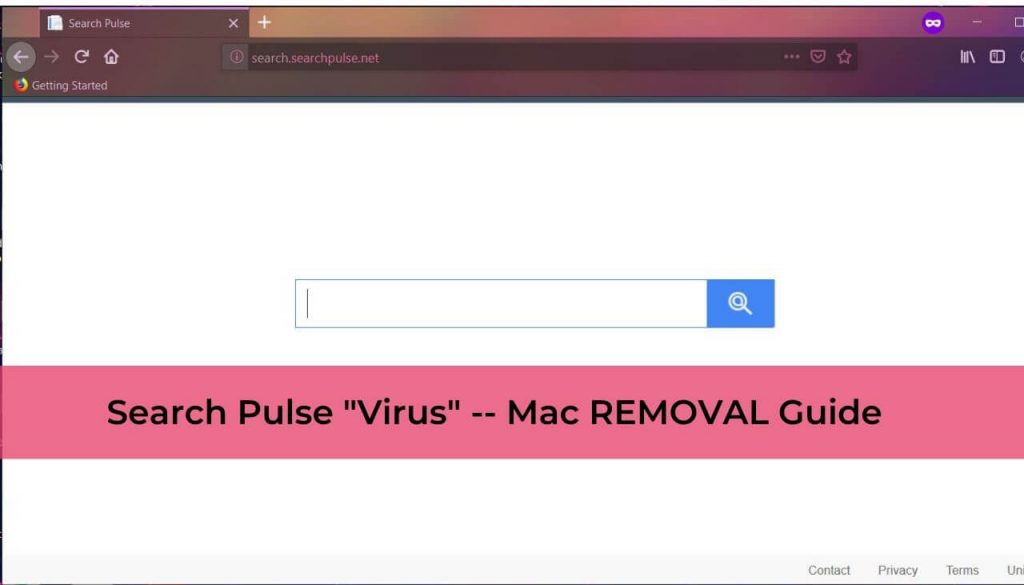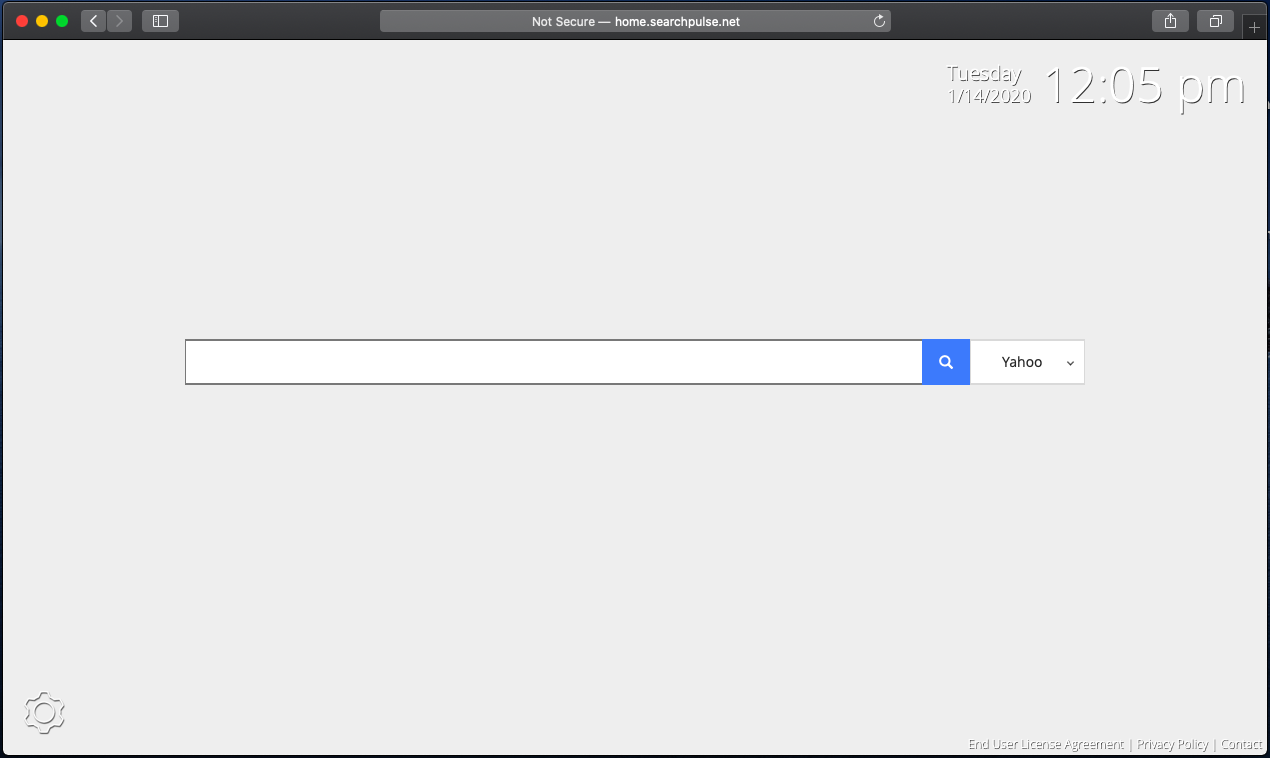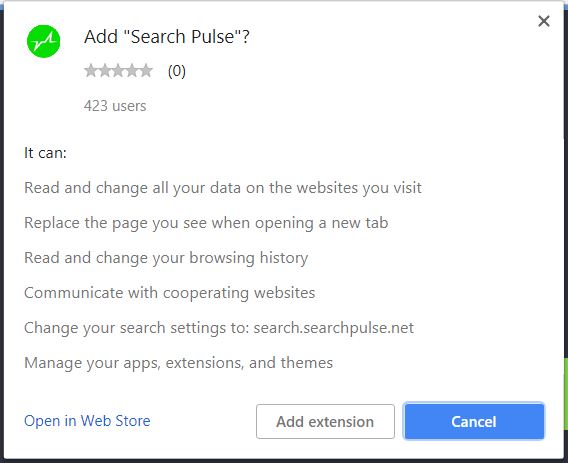Wondering what Search Pulse virus is, and how to remove it from Safari or Chrome browsers and Mac systems? Follow the detailed guide at the end to see how to get rid of Search Pulse undesired program.
What Is Search Pulse?
Search Pulse is an app that could find a way to run on your system without your knowledge. Even though this program claims to be a search manager that improves your browsing experience it is a bogus app that attempts to harvest specific data from affected Safari, Chrome or another preferred web browser so it can then provide the data to its unknown owners. Along with this, it could be used for the delivery of many annoying ads directly in the browser. The Search Pulse browser hijacker also changes browser search provider to Search Pulse. This hoax search engine is designed to redirect affected users to search result pages from Yahoo Search. This way the undesired program is probably generating advertising revenue to its operators by using Yahoo Search for its search results. To sum up, Search Pulse is a potentially unwanted program that should be removed from the affected Mac system and web browsers as soon as possible.

Threat Summary
| Name | Search Pulse |
| Type | Browser Hijacker for MacOS |
| Search Pulse on Windows | Searchpulse.net Windows PC Removal Guide |
| Short Description | Search Pulse aims to heavily modify the settings of installed web browsers so that it can start pushing all sorts of third-party ads. The app can steal sensitive data from the affected system and browser. |
| Symptoms | You may start noticing system performance issues as well as many redirects to bogus web pages pushed by Search Pulse. |
| Distribution Method | Via software bundling or downloading a PUA (Potetially Unwanted Application) |
| Detection Tool |
See If Your System Has Been Affected by malware
Download
Combo Cleaner
|
Why is Search Pulse on Mac?
If your Mac is constantly being redirected to the suspicious websites and your browser homepage and search engine have been changed to Search Pulse search engine without your consent, then your Mac is infected with an unwanted/malicious program installed.
A reddit user shared the following complaint about Search Pulse virus on his Mac:
Posted byu/calciumlithium_
1 month ago
How do I get rid of Search Pulse from Mac?Is anyone familiar with the search pulse virus? My Macbook acquired it last week. Whenever I open Safari, Search Pulse pops up (search.searchpulse.net). It also pops up when I open a new tab/window. I downloaded a malware software when I first noticed that I got it. The software detected it, I followed the steps provided to delete it, and I then restarted my computer. But search pulse still popped up when I opened Safari. I then ran the malware program a second time but it came back as my computer being clean. I downloaded a second virus program and that one, too, showed my computer as being clean. I made sure the search pulse was not set as my homepage, it isn’t listed as an extension, and I deleted all caches and cookies. But this search pulse website continues to open up in each Safari window. Does anyone know how to remove this malware for good? Any help would be very, very much appreciated!
Another user on Apple Community Forums had the following to share about Search Pulse Virus:
Search Pulse Malware
I have tried everything to remove Search Pulse from my MacBook.
On my Safari, no extensions show up at all. I tried to change my homepage, but it’s showing up as what I set it to and won’t let me make any changes to it.
As an unwanted application Search Pulse is being distributed via shady techniques that trick you into installing it without noticing it. It is most likely that freeware installers and bundled packages are used for its spread. So you may have unnoticeably installed it on your Mac along with another desired app. This nasty side effect usually happens due to the fact that the presence of potentially undesired extra apps is not disclosed properly in the installers of freeware apps. Sometimes the unnoticed installation of unwanted apps like Search Pulse can be avoided with a thorough read of the information listed under the Advanced or Custom configuration option. There you may find out apps you don’t need and opt-out their installation.
Suspicious websites are another approach for the distribution of PUPs like Search Pulse. By visiting such a website you can let the undesired app infiltrate your macOS on the back of your browser. For the installation process, the rogue app may trigger a pop-up that forces you to install a fake software update or follow certain steps that will help it bypass active security measures.
Yet another online place where the deceptive Search Pulse app (searchpulse.net) is offered it its official website.
As of November 2019, the Search Pulse Mac virus is propagated with the help of fake Adobe Flash Player updates. And in February 2020 this technique is still in use for the propagation of this nasty application.
What else do you need to know about the Search Pulse virus on Mac?
Many users whose systems get infected with Search Pulse consider the app as a Mac virus. But is Search Pulse a virus? In fact, Search Pulse is a browser hijacker that aims to alter browser settings, spy on users’ online behavior and display intrusive ads in an attempt to monetize its presence on an affected system. Hence, Search Pulse is classified as a potentially unwanted program.
Once started on your Mac the undesired app Search Pulse modifies main settings of installed browsers. To investigate the behavior of Search Pulse virus we installed it as an extension on a Chrome browser. In fact, it became clear that the potentially unwanted program wants to be authorized to perform all of the following actions in order to be installed:
- Read and change all your data on the websites you visit
- Replace the page you see when opening a new tab
- Read and change your browsing history
- Communicate with cooperating websites
- Change your search engine to: search.searchpulse.net
- Manage your apps, extensions, and themes
After all these issues occur Search Pulse virus becomes able to collect various sensitive details from the affected browser. It keeps a record of collected data on its servers. To record certain details the undesired app activates tracking technologies like cookies, javascript, web beacons and other. All of the following details may be collected by the app and used by its unknown owners:
- Browsing history
- Browser’s home page
- Search queries
- Type of used browser
- Operating system type
- Internet protocol (IP) address
- Geographic location
- The domain name of current Internet service provider (ISP)
As it appears the nasty Search Pulse virus app replaces your default search engine with search.searchpulse.net or home.searchpulse.net. These domains host hoax search engines that affect trustworthy browsers with the goal to obtain search queries, track browsing history and generate sponsored results. The homepage box in the preferenced of an affected Safari can appear as an unclickable blank. Hence, you may be unable to add a preferred homepage.
After entering a search query in an affected browser, the hijacker redirects users to search.yahoo.com results. This issue is related to the so-called Yahoo virus. By redirecting affected browsers to Yahoo search the Search Pulse virus app aims to generate revenue for its operators. Beware as the searching results generated by the hijacker may present misleading content and links to hacked websites. The results are also likely to be flooded with lots of sponsored content.
As long as Search Pulse virus app is running on your Mac and has access to your Safari/Chrome or another installed web browser, it may be generating other types of ads in the browser including pop-ups, pop-unders, banners, redirects, and in-text links. This issue is caused for the purposes of money revenue too. Apps like Serch Pulse are designed to spy on users’ online behavior, provide data to their owners and generate ads based on the collected data. Their owners often bet on the pay-per-click advertising model as it enables them to get paid for every click on an ad generated by their tool. What may be the consequences? Do these ads pose a certain risk to your online security?
On the one hand, the performance of your system and browser may be slowed down. On the other hand, the security of your system is at high risk of infection with serious malware like is the Shlayer Trojan. Hence, the data stored on system drives may be endangered too.
If you want to keep your system protected against malware and your personal data private, you need to remove Search Pulse virus from Safari and Mac as soon as possible.

How to Remove Search Pulse Virus from Mac
In order to remove Search Pulse virus from Mac make sure to complete all the steps listed in the removal that follows. It will help you to remove Search Pulse from Safari and Chrome too. Unfortunately, Search Pulse is not always in the extensions list. Hence, its associated files cannot be uninstalled by simply closing the browser and dragging the undesired app to the Trash. This nasty program creates “profiles” in the system preferences and you have to delete them. If you want to remove the Search Pulse from your Mac OS in full we recommend that you use a specific anti-malware for Mac. The program will scan your operating system and terminate files with malicious patterns. It will also clean up any malicious code in your repositories. With a specific anti-malware program, youр Mac will be protected better in the future.
In case you have further questions or need additional help, don’t hesitate to leave a comment or contact us via email.
Steps to Prepare Before Removal:
Before starting to follow the steps below, be advised that you should first do the following preparations:
- Backup your files in case the worst happens.
- Make sure to have a device with these instructions on standy.
- Arm yourself with patience.
- 1. Scan for Mac Malware
- 2. Uninstall Risky Apps
- 3. Clean Your Browsers
Step 1: Scan for and remove Search Pulse files from your Mac
When you are facing problems on your Mac as a result of unwanted scripts and programs such as Search Pulse, the recommended way of eliminating the threat is by using an anti-malware program. SpyHunter for Mac offers advanced security features along with other modules that will improve your Mac’s security and protect it in the future.

Quick and Easy Mac Malware Video Removal Guide
Bonus Step: How to Make Your Mac Run Faster?
Mac machines maintain probably the fastest operating system out there. Still, Macs do become slow and sluggish sometimes. The video guide below examines all of the possible problems that may lead to your Mac being slower than usual as well as all of the steps that can help you to speed up your Mac.
Step 2: Uninstall Search Pulse and remove related files and objects
1. Hit the ⇧+⌘+U keys to open Utilities. Another way is to click on “Go” and then click “Utilities”, like the image below shows:

2. Find Activity Monitor and double-click it:

3. In the Activity Monitor look for any suspicious processes, belonging or related to Search Pulse:


4. Click on the "Go" button again, but this time select Applications. Another way is with the ⇧+⌘+A buttons.
5. In the Applications menu, look for any suspicious app or an app with a name, similar or identical to Search Pulse. If you find it, right-click on the app and select “Move to Trash”.

6. Select Accounts, after which click on the Login Items preference. Your Mac will then show you a list of items that start automatically when you log in. Look for any suspicious apps identical or similar to Search Pulse. Check the app you want to stop from running automatically and then select on the Minus (“-“) icon to hide it.
7. Remove any leftover files that might be related to this threat manually by following the sub-steps below:
- Go to Finder.
- In the search bar type the name of the app that you want to remove.
- Above the search bar change the two drop down menus to “System Files” and “Are Included” so that you can see all of the files associated with the application you want to remove. Bear in mind that some of the files may not be related to the app so be very careful which files you delete.
- If all of the files are related, hold the ⌘+A buttons to select them and then drive them to “Trash”.
In case you cannot remove Search Pulse via Step 1 above:
In case you cannot find the virus files and objects in your Applications or other places we have shown above, you can manually look for them in the Libraries of your Mac. But before doing this, please read the disclaimer below:
1. Click on "Go" and Then "Go to Folder" as shown underneath:

2. Type in "/Library/LauchAgents/" and click Ok:

3. Delete all of the virus files that have similar or the same name as Search Pulse. If you believe there is no such file, do not delete anything.

You can repeat the same procedure with the following other Library directories:
→ ~/Library/LaunchAgents
/Library/LaunchDaemons
Tip: ~ is there on purpose, because it leads to more LaunchAgents.
Step 3: Remove Search Pulse – related extensions from Safari / Chrome / Firefox









Search Pulse-FAQ
What is Search Pulse on your Mac?
The Search Pulse threat is probably a potentially unwanted app. There is also a chance it could be related to Mac malware. If so, such apps tend to slow your Mac down significantly and display advertisements. They could also use cookies and other trackers to obtain browsing information from the installed web browsers on your Mac.
Can Macs Get Viruses?
Yes. As much as any other device, Apple computers do get malware. Apple devices may not be a frequent target by malware authors, but rest assured that almost all of the Apple devices can become infected with a threat.
What Types of Mac Threats Are There?
According to most malware researchers and cyber-security experts, the types of threats that can currently infect your Mac can be rogue antivirus programs, adware or hijackers (PUPs), Trojan horses, ransomware and crypto-miner malware.
What To Do If I Have a Mac Virus, Like Search Pulse?
Do not panic! You can easily get rid of most Mac threats by firstly isolating them and then removing them. One recommended way to do that is by using a reputable malware removal software that can take care of the removal automatically for you.
There are many Mac anti-malware apps out there that you can choose from. SpyHunter for Mac is one of the reccomended Mac anti-malware apps, that can scan for free and detect any viruses. This saves time for manual removal that you would otherwise have to do.
How to Secure My Data from Search Pulse?
With few simple actions. First and foremost, it is imperative that you follow these steps:
Step 1: Find a safe computer and connect it to another network, not the one that your Mac was infected in.
Step 2: Change all of your passwords, starting from your e-mail passwords.
Step 3: Enable two-factor authentication for protection of your important accounts.
Step 4: Call your bank to change your credit card details (secret code, etc.) if you have saved your credit card for online shopping or have done online activiites with your card.
Step 5: Make sure to call your ISP (Internet provider or carrier) and ask them to change your IP address.
Step 6: Change your Wi-Fi password.
Step 7: (Optional): Make sure to scan all of the devices connected to your network for viruses and repeat these steps for them if they are affected.
Step 8: Install anti-malware software with real-time protection on every device you have.
Step 9: Try not to download software from sites you know nothing about and stay away from low-reputation websites in general.
If you follow these reccomendations, your network and Apple devices will become significantly more safe against any threats or information invasive software and be virus free and protected in the future too.
More tips you can find on our MacOS Virus section, where you can also ask any questions and comment about your Mac problems.
About the Search Pulse Research
The content we publish on SensorsTechForum.com, this Search Pulse how-to removal guide included, is the outcome of extensive research, hard work and our team’s devotion to help you remove the specific macOS issue.
How did we conduct the research on Search Pulse?
Please note that our research is based on an independent investigation. We are in contact with independent security researchers, thanks to which we receive daily updates on the latest malware definitions, including the various types of Mac threats, especially adware and potentially unwanted apps (PUAs).
Furthermore, the research behind the Search Pulse threat is backed with VirusTotal.
To better understand the threat posed by Mac malware, please refer to the following articles which provide knowledgeable details.








When I remove it from Safari, it keeps coming back. Can you assist ?
After you download the removal tool – Combo Cleaner, make sure to scan your Mac. If the Combo Cleaner doesn’t detect SearchPulse virus, you should activate the full Combo Cleaner by purchasing it and then you should contact Combo Cleaner’s live support team – they will remove it manually from your computer so that you don’t have to deal with it anymore :). I hope this helped.
What is you can’t find the file? I looked in my utilities and apps–nothing comes up that looks like it doesn’t belong there, necessarily.
Hi Diana,
In case you cannot find the virus files and objects in your Applications or other places we have shown above, you can manually look for them in the Libraries of your Mac. We have instructions for this as well, they are right under Step 1 (with a disclaimer you should read carefully). Hope this helps.